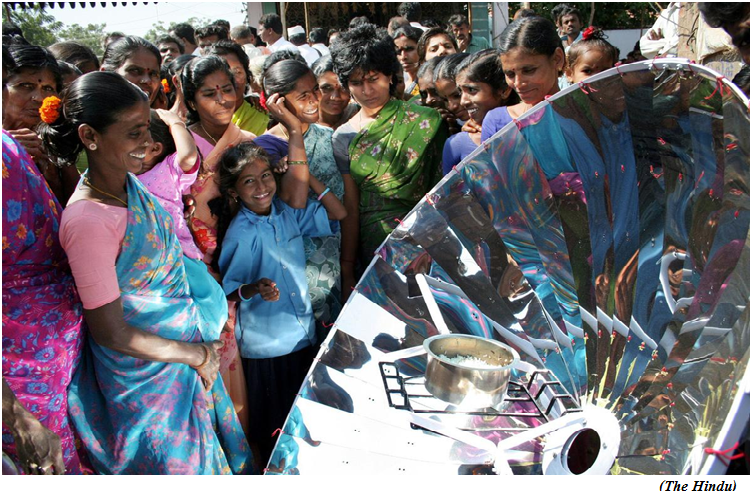Smoke signals from the renewable energy sphere (GS Paper 3, Environment)

Context:
- While past governments have failed to convince women to transform their household energy use through technical innovation, today, we are at an unprecedented crossroads in India’s renewable energy history.
Recent launch of solar cook-stove:
- The formal launch of the Indian Oil Corporation’s patented solar cook-stove at the India Energy Week 2023 (February 6-8, 2023 in Bengaluru as part of the G-20 calendar of events) by the Prime Minister must be looked at closely from the point of view of India’s national energy story.
- These pronouncements have followed a 99% cut in the liquefied petroleum gas (LPG) subsidy (from the 2022-23 revised estimates) to low-income households in the 2023 Budget even as international fuel prices remain high.
- The government has claimed that the stove, priced at an eye-watering ₹15,000 will transform cooking practices, save thousands of crores in LPG cost and forex, cut carbon dioxide emissions, and yield marketable carbon credits.
- While past governments have failed to convince women to transform their household energy use through technical innovation, today, we are at an unprecedented crossroads in India’s renewable energy history.
A quest derived from crises:
- The quest for renewable and decentralised technology in poor households has closely followed energy crises.
Solar cooker in early 1950s:
- Among the government’s earliest attempt to transform household energy consumption was the solar cooker of the National Physical Laboratory (NPL), fabricated in the early 1950s, in a period of great uncertainty in food security and energy self-sufficiency.
- The Nehru government’s gambit on state-led hydroelectric power generation was a response to this crisis, but it failed to address the household energy consumption of the rural poor.
- The solar cooker was met with international press coverage and newsreels in the cinema. But the ‘indigenous’ device, based on a 19th century innovation, was dead in the water. Apart from its prohibitive price, it cooked very slowly.
Smokeless chulha:
- Parallel efforts to improve the traditional stove proved similarly ineffective.
- For example, the Hyderabad Engineering Research Laboratories made a ‘smokeless chulha’ in 1953, the brainchild of its director S.P. Raju, who wished to bring “smokeless kitchens for the millions”.
- These stoves incorporated traditional cooking practices and locally sourced materials, but surveys documented the chulha’s limited uptake among rural women as it was found wanting in its design and durability.
- Thereafter, the oil crisis of 1973 and an emerging forest conservation movement trained government attention on stoves that used firewood and cow dung.
Improved stove in 1980s:
- Accordingly, in the 1980s, the government turned to “improved chulhas” in its national energy policy. The programme sought to check deforestation by reducing fuelwood consumption and also benefit women’s health and finances.
- It was launched in 23 States and five Union Territories. An extensive federated system was set up, from nodal State agencies to “self-employed workers”, to fulfil targets set by the national administration.
- The sole incentive to adopt the “improved chulhas” was a 50% subsidy. The Ministry of Non-conventional Energy Sources (renamed as Ministry of New and Renewable Energy) claimed that the chulha had been adopted in over 32 million homes, out of a potential 120 million, by 2001.
- But, by the next year, the programme had folded up. The reasons for failure included the stove’s construction, high maintenance costs, and alleged bureaucratic corruption. State governments had little autonomy apart from meeting pre-set targets while workers charged with installations were underpaid.
- Despite this outcome, the United Progressive Alliance regime repackaged the scheme in 2009 as the ‘National Biomass Cookstove Initiative’, which has continued to totter on as the ‘UnnatChulha Abhiyan’ from 2014.
- Today, despite the purported success of the government’s LPG scheme, unprecedented inflation in fuel prices and the gradual withdrawal of subsidies have forced women to resort to the chulha with all its hazards.
Conclusion:
- There are obvious parallels between the government’s boost to Indian Oil’s solar stove and this history: a public-sector innovation with supposedly revolutionary impact after a fuel crisis; a gulf between state-subsidised schemes and its practical implementation; and the absence of any long-term goal to improve rural incomes despite the correlation between per-capita income and type of energy consumption.
- But the similarities end here. While older interventions in the renewable sphere were led by the state and motley non-governmental organisations, which provided shallow fixes to deep social problems, today, the real action is elsewhere.
- Public money is now funnelled into heavily subsidised large-scale private projects that produce green energy largely for commercial use. Today, technical innovation in renewable energy policy, despite its pretensions, serves to entrench a highly uneven energy landscape.


